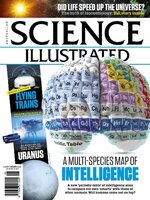Science Illustrated delivers natural science, break through discoveries and an understanding of the world for the entire family. Packed with stunning photography and in-depth editorial it’s a visually spectacular gateway to the world looking into the beginning of life to distant objects in the universe.
SUBSCRIBE & START SAVING NOW!
Science Illustrated Australia
Close-up: JunoCam’s close encounter
‘Art Of Science’ finalist: milk muscles
New space phenomenon: Star survives supernova • Stars normally disappear after a supernova, with the core becoming either a neutron star or a black hole, and the rest spreading out as nebulas. But now a star has survived an explosion, shining more brightly than ever. The discovery could significantly change our understanding of supernovas.
30,000-year-old mammoth calf emerges from the permafrost • An almost complete woolly mammoth calf was accidentally discovered in the Canadian permafrost. It is only the second time that scientists have ever discovered a baby mammoth, and the first time in North America.
NASA aims to construct a nuclear reactor on the Moon • The American space agency has initiated a contest to produce the best idea for a nuclear reactor that could be ready to use on the Moon before 2030. The new reactor would provide energy for ongoing space missions to our satellite.
Huge bacterium can be observed with the naked eye • Scientists have discovered a huge bacterium in a Caribbean mangrove. It is 5000 times bigger than most comparable bacteria and it also behaves unlike its smaller peers.
Scientists prolong the life of rechargeable batteries by 30% • Thanks to a method that revives ‘dead’ lithium, owners of electric cars might soon benefit from batteries with 30% longer life.
Can we ever achieve 100% renewable power? • The energy crisis is forcing governments to extend or renew their use of fossil fuels instead of switching to green energy. Can we ever achieve fully-renewable power generation?
Do animals have different blood types? • Humans have a number of different blood types, but is this also true for animals? How many types do dogs have?
Are fingerprints truly unique? • Is it really true that everybody – even twins – has a different set of fingerprints?
3 main patterns make us different • The many possible combinations of three main types of fingerprint – and their finer details – make them reliable for ID.
Can any animal get an itch?
Could the rain be any worse? • How does Australia’s rainfall compare with world records?
WHAT IS THIS? · Why are some mountain tops flat? • “I was in South America last autumn, and when we travelled through Venezuela, we saw mountains where the tops were almost completely flat. How did they form?”
Does the Russian president have a nuclear button?
… one Polish village produces only girls? • For a decade, no boys were born in a Polish village. What are the chances of this?
Chromosomes determine gender • A baby’s gender is determined by the sperm cell that enters the egg.
ASTRONOMY: SKY COUNTRY • ‘Astronomy: Sky Country’ is the fourth in a series of books titled ‘First Knowledges’. The excerpts that follow offer just a small taste of the ideas and ingenuity within their pages.
Shy sister the world’s oldest story?
The Dark Emu
Navigation
The scales of time
Cultural competency
Tackling skyglow
An app for that
SO MUCH SCIENCE!
GREEN CITIES WILL CHANGE HOW WE ALL LIVE & WORK • Cities of the future could be unrecognisable. Suburbs will no longer exist, and grasslands will replace city streets. The latest climate-friendly city plans envisage entirely new structures to become our future homes.
A...

 Issue 111
Issue 111
 Issue 110
Issue 110
 Issue 109
Issue 109
 Issue 108
Issue 108
 Issue 107
Issue 107
 Issue 106
Issue 106
 Issue 105
Issue 105
 Issue 104
Issue 104
 Issue 103
Issue 103
 Issue 102
Issue 102
 Issue 101
Issue 101
 Issue 100
Issue 100
 Issue 99
Issue 99
 Issue 98
Issue 98
 Issue 97
Issue 97
 Issue 96
Issue 96
 Issue 95
Issue 95
 Issue 94
Issue 94
 Issue 93
Issue 93
 Issue 92
Issue 92
 Issue 91
Issue 91
 Issue 90
Issue 90
 Issue 89
Issue 89
 Issue 88
Issue 88
